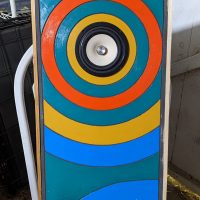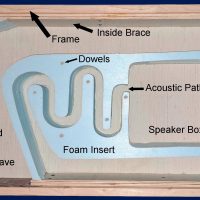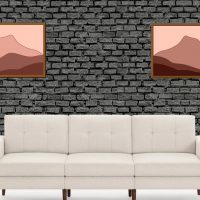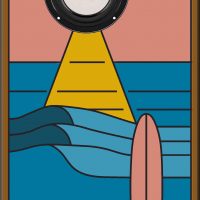
FH-5 Art and Folded Horn
Designer:
John E Henderson
Project Category:
Bookshelf Speakers
Project Level:
Intermediate
Project Time:
20+ Hours
Project Cost:
$100 – $500
Project Description:
Hi. I am asking for input on this design. Please don’t laugh! This thing took on a life of its own. I will explain.
My idea was to add some sound to a painting. For example, I wanted to paint a mountain river on a stiff piece of wood and add the sound of babbling stream by adding an exciter to the back. The project grew into what you see below. It is now a wall mounted speaker with a painted baffle.
Since I knew so little about DIY speakers, I hit the internet to do some research. I found myself enthralled by speaker design, and my idea of something simple morphed into a 6 month adventure into the world of audio design. I decided on a design with a single driver that I would incorporate into the painting. Remember, this started as an art project. I liked a design I found in a forum called a folded horn. I copied it, then modified it a bit to suit my project. Since I know nothing of the principles involved, I did make sure that the dimensions of the horn did not change from the original. I wish I knew who to credit for the design, but I don’t. I will say, bless all of you guys that so willingly share your designs.
The result is well beyond my expectation for sound quality, but I can’t help thinking they could be better, especially on the low end (of course).
I power them with a Dayton Audio Amp and a Dauk tubed preamp with tone control.
My ears are the only instrument I have with which to measure the sound, and the Hit Makers my only reference. I find it very difficult to describe sound, but I will give it my best shot. Keep in mind that I know very little about audio design, so…
First, they are considerably louder than the Hit Makers, and the sound clarity was at least equal to them. The Hit Makers had a richer bass, but not nearly the presence. My speakers just fill the room (12 x 12) with music that is crystal clear, where the Hit Makers have a much more defined point of origin. Does that make sense?
When I listen to (Lets say, School, by Supertramp) with the tone control bypassed, I just don’t get the thumping notes I hear with the Hit Makers. However, when I turn the bass up on the preamp, they really come alive. They don’t’ have the same crispness in the bass notes that I would like to hear, but a solid response nonetheless. Overall, I really can’t believe how good they sound when I adjust the tone to my liking.
By the way, I tried them without the horn. I left the inside empty and sealed box. It sounded different, but I don’t think it was better. The bass may have improved a touch, but the overall sound was not as good to my ears. Again, it is hard for me to describe, but after a while they felt like they were screeching at me with just the sealed box. With the horn insert installed, they just seemed much smoother and less fatiguing to my ears.
Design Goals:
1. Incorporate the driver into the art work.
2. It needed to be light enough to hang on a wall.
3. It needed to sound decent.
4. Staying under $250 for the set was a must.
Driver Selection:
Parts Express Part #264-958 Tang Band W5-2143 5 inch full range.
Enclosure Design:
Folded Horn cut from sheet foam in plywood cabinet. The inside dimensions are 30 x 15 x 3 inches and they weighs 15 pounds each. They mount to the wall using French cleats, and I use a rubber backing to keep it snug. The idea is to help reduce vibration since they are intentionally lightweight.
Enclosure Assembly:
Cut by CNC, Glued and screwed. I have added pictures of several of my designs to this point, and an image of the inside of the box.
Crossover Design:
na
Tips & Tricks:
Conclusion:
My intent is to make several of these for an art show later in the year, and I want them to sound as good as possible without changing the dimensions too much. Again, the project is supposed to be more about the art than the sound. It just morphed into a sound project instead.
I guess my question is: What would you do to improve this design?
About the Designer:
I am a retired graphic designer. I have minimal experience with DIY speakers. My only successful attempt to this point is a “Hit Makers” kit I built many years back, and a half dozen old radio conversions. I mention this so you know that technical talk is going to be meaningless to me. But, if anyone has any ideas or comments, I would love to hear them.
Project Parts List:
|
Part # |
Description |
Qty |
|
264-958 |
Tang-Band-W5-2143-5-Paper-Cone-Full-Range-Driver-8-Ohm-264-958 |
1 |





I think that is a cool project. I’ve a couple comments, your horn seems to narrow at several places. This is bad. Your horn should have a steady increase in area along the throat to the mouth. You can get into some significant math trying to build your own horn. So, what I propose is building a 1/4 wavelength transmission line. This is relatively easier. You can usually get good results with some simple rules of thumb. Find the resonance of your loudspeaker driver. Calculate the resonant frequency wavelength L=v/f (wavelength = velocity of sound (1,125ft per second) divided by resonant frequency). Next divide that number by 4. This is the appropriate length of your transmission line. Next find the area of your speaker cone. This is the cross section area of the t-line. Put a slight taper in the t-line towards the exit port. You can build this as another insert to your art frame. Another experiment! Also, you should put a bit of fiberglass in the box behind your speaker drivers to reduce high frequency echoes. This might remove some of the harshness you hear.
With the T-line you could use the speaker driver as a sun and the T-line port as a black hole or moon?